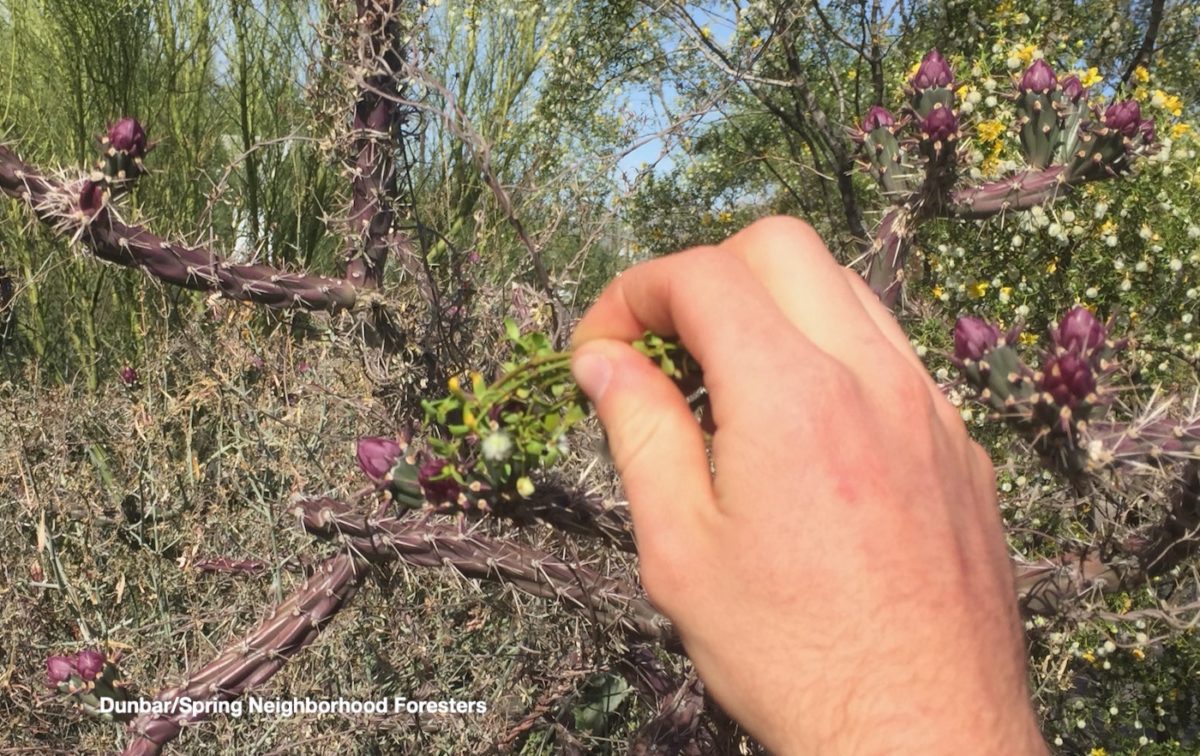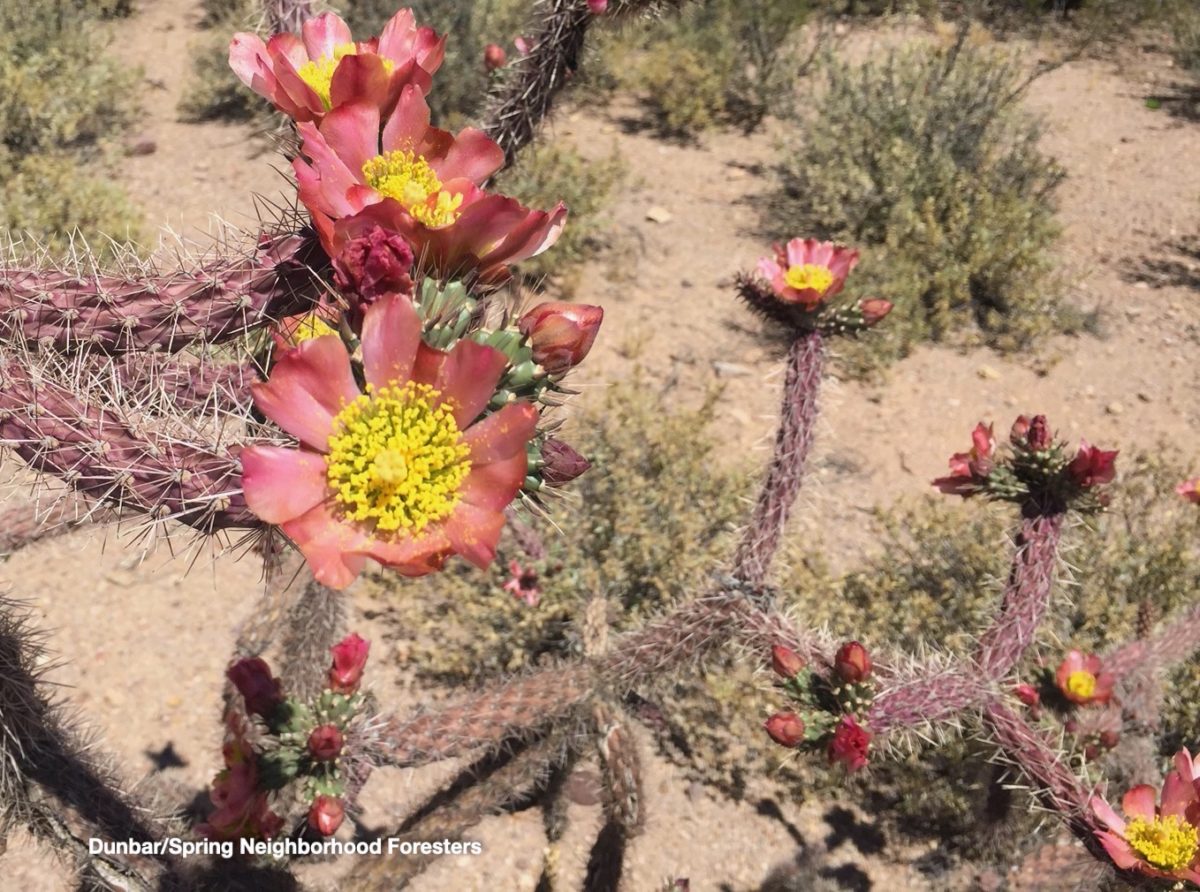Yes, cholla cactus is thorny, but it has a caring heart, delicious flower buds, and so much more.

When I learned how to harvest, process, and enjoy the tasty, calcium-rich flower buds I no longer saw the plant simply as thorns to be avoided. Instead, I saw a hardy food plant that thrives on natural rainfall alone.
Wildlife habitat
While harvesting the flower buds, I spent more time with the cholla and learned from it. I discovered what a rich habitat it was for wildlife such as the birds that nested within it and the many pollinators visiting its flowers.




Selecting and planting more cholla for best characteristics
I also discovered the staghorn cholla (Opuntia versicolor) has a about a dozen different flower colors, each plant reliably blooming the same color each year (scroll to end of this blog essay for photos of different flower colors).
So, now friends and other Neighborhood Foresters and I take and plant cuttings based on bloom color, flower bud size, and buds with fewer thorns (the flower buds are edible and delicious after de-thorning and cooking). When then mark that cutting’s characteristics on its planting pot with a wax pencil (along with an “X” on the side of the pot facing south, so when transplanted into the ground, the south-facing side of the cholla plant will still be south-facing—avoiding sunburn to the plant that would occur if the orientation were changed).
Note that when I harvest the canes, I don’t mark their south-facing side, but when I pot them up I do. The south-facing side tends to be more purple or “tanned”, while the side getting less direct sun exposure is a lighter color. The flower buds also tend to grow up toward the light and the sun, so it is fairly easy to then mark an X on the side of the pot to which the “tanned” skin of the cholla cane is facing.


Once the cuttings are well rooted, we then distribute the plants to those in the neighborhood that want to plant and care for them. Doing so, neighbors can choose their cholla plant by flower color, then plant it in their section of the neighborhood forest.

More on staghorn cholla
Below is information I compiled long ago while creating a list of multi-use plants native to Tucson…
OPUNTIA SPP. – CHOLLA
(Cactaceae – Cactus Family)
subgroup Cylindropuntia:
Spanish name: cholla
O’odham name: ciolim
Yeome name: choa
Plant has cylindrical stems or “joints”.
Wildlife – bees love the flowers; cactus wren, curve-billed thrashers, and other birds go for the fruit and nesting possiblities.
Edible – flower buds are picked just before opening, de-thorned, cooked, and eaten or dried for later use (Niethammer, 1987), (FOG); a four ounce serving of cholla buds gives you as much calcium as a glass of milk (Niethammer, 1987); the roasted buds were mixed with Atriplex wrightii and Chenopodium album for a vegetable stew (Ebeling, 1986); fresh cholla fruits can also be peeled and eaten, made into marmalade, or candied (Niethammer, 1987); the fruits and prickly joints of the cactus were also cooked and eaten like the flower buds (Niethammer, 1974); seeds can be used in a wild flour mixture (Nyerges, 1998); Good food for diabetics (Dahl, 1995), (Nabhan, 1991). Harvest begins in April (Dahl, 1995).
Medicinal (Niethammer, 1974).
Other uses – plant as a security screen; some of the gums obtained from cholla plants have been used as a cloth-stiffener in Mexican textile mills (Niethammer, 1974). Evergreen.
Low-water-use (1).
OPUNITA VERSICOLOR – STAGHORN CHOLLA:
The species name versicolor, refers to the variability of the color of the flowers. Fruit is usually spineless. 2,000 – 3,000′. Tree-like in form with an open crown. Grows 3 – 15′ tall.
Wildlife – mule deer eat the fruit (Felger and Moser, 1985).
Edible – fruit eaten fresh once thorns were removed (Felger and Moser, 1985); de-thorned flower buds eaten by Tohono O’ Odham; flower buds harvested in the spring are roasted and eaten as a minor food by the Gila Pima (Rea, 1997). I eat the flower buds just before they bloom when hiking in the desert in spring. I dethorn them first by brushing them with a brush of plant twigs or rubbing them on a rock or gravel with a stick and then picking off the rest by hand, then I pop them in my mouth and chow down. I find their slimy texture very nice on hot, dry hikes as they reduce my thirst and fill my belly.
Interested in a neighborhood-grown cholla plant to plant and steward in your section of the neighborhood forest?
And you want to choose your plant’s bloom color?
Email us at NeighborhoodForesters@gmail.com








